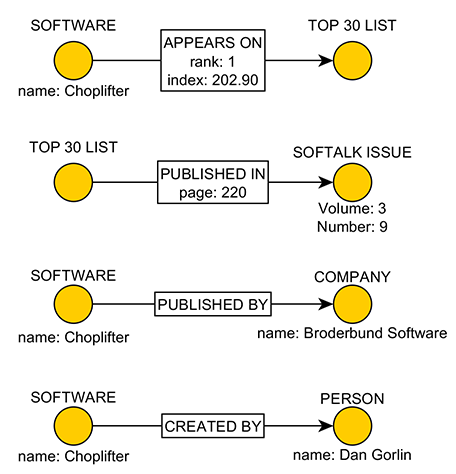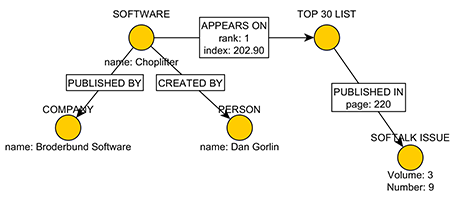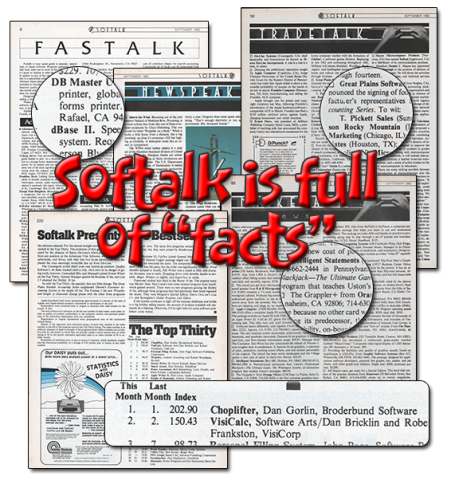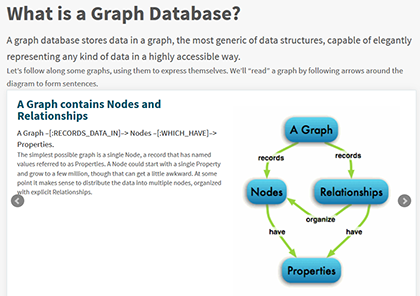The Softalk magazines are brimming with "facts" about the Microcomputer Revolution. This overview will tell you a bit about how we will use graph database technology to unlock this incredible resource within our 9,100-page treasure trove.
The core data modeling constructs of a graph database are "nodes" and "relationships." I could tell you more, but this short four-slide explanation on the Neo4j website nails it. (Neo4j is the Open Source graph database from Neo Technology that we will be using for this project and for the Fact Miners social game app platform.)
The graph database's [NODE] => [RELATIONSHIP] => [NODE] construct can be used to create a flexible "grammar" that both organizes known information AND provides the flexibility to organically evolve your information model as new information is discovered and we expand our understanding of interrelationships within our data. In short, a graph database is ideal for creating The Softalk Apple Project "Fact Cloud" Companion.
Let's take a look at one simple example: "Choplifter is the #1 bestseller on the Top Thirty list in the October 1982 issue of Softalk."
We start with this elementary structure:
![An elementary graph DB 'fact' - [Node] => [Relationship] => [Node]](../sites/default/files/images/FactCloud_1.png)
With this simple construct, we can express "facts" (elementary assertions) such as:
- ["Joe"] => ["Likes"] => ["Jane"]
- ["The sky"] => ["Is_color"] => ["blue"]
- ["Acme Inc."] => ["Makes"] => ["Widgets"]
Simple, powerful... but you can see where things would get gnarly quickly if everything had to be expressed, stored, and retrieved at such a fine-grained level. So, beyond this core construct, a graph database (like Neo4j) can allow labels and property lists to be attached to Nodes and Relationships providing additional "flavors" of expression within our data model:

These label and property-list "decorations" dramatically enhance the range of what can be expressed in the information model of a graph database – a "fast bike" rather than a "bike" which can itself be labeled as a type of "vehicle." Before we quickly get beyond the "wee bit" focus of this page, let's look at how we can use this notation to "gather the facts" that we know from this one line in the Top Thirty list in the October 1982 issue...

If we put these elementary "facts" together in a connected graph, you see the start of a "Fact Cloud"...

Now imagine a voracious social game-playing community of "Fact Miners" descending on The Softalk Apple Archive. Imagine how many "facts" this crowdsource resource could find on a single page of the magazine. Extrapolate that out to a full issue, then imagine if all 9,100+ pages of the 48 issues of Softalk were mined for their embedded facts. Imagine what an unprecedented education and research resource could be created by a bunch of folks having some "serious fun."
This is our vision for the Softalk Apple Archive "Fact Cloud Companion" that we will create through this project and its "spawn" of the www.FactMiners.com social-game community and the www.FactMiners.org developer community.
(You may want to hop back to the About page...)



Comments
OMG! And actual thoughtfully WONDERFUL comment!!! Yes, thank you
Hello Hazzard567,
You made our day! We don't yet know who you are or anything else, but even if you are simply trying to seed places with your service offering signature link, this comment is SPOT ON as the Brits say. The amazing exploratory value to the casual and serious research visitor is the objective of our FactMiners' applied research at The Softalk Apple Project. A FactMiners' Fact Cloud of the four years of Softalk content will indeed be a unique and valuable addition to our on-line cultural assets.
Thank again for your comment.
-: Jim and Timlynn :-
Happy-Healthy Vibes to All,
-: Jim Salmons :-
@Jim_Salmons
@FactMiners
FactMiners Founder and Project Lead
(Cedar Rapids, Iowa USA)